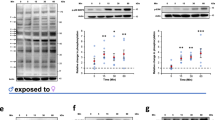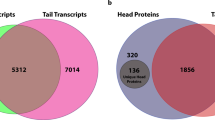Abstract
Sexual dimorphism in blood flukes of the family Schistosomatidae is marked, and until the male clasps the female in the gynaecophoric canal the female cannot attain sexual maturity1 or migrate out of the liver2. When previously-paired egg-producing females are transferred to a new host without males, the vitelline cells necessary for egg production degenerate3. By means of sensitive fluorographic analysis of electrophoresed polypeptides, we have now found molecular evidence of an obligatory continuous relationship between the sexes in Schistosoma mansoni. The male worm retains little of the protein it produces in greatest abundance, and this protein is electrophoretically identical to the most abundant protein found in, but not synthesised by, the female.
This is a preview of subscription content, access via your institution
Access options
Subscribe to this journal
Receive 51 print issues and online access
$199.00 per year
only $3.90 per issue
Buy this article
- Purchase on Springer Link
- Instant access to full article PDF
Prices may be subject to local taxes which are calculated during checkout
Similar content being viewed by others
References
Armstrong, J. C. J. Parasit. 51, 605–616 (1965).
Standen, O. D. Ann. trap. Med. Parasit. 47, 139–145 (1953).
Clough, E. R. & Schiller, E. L. in Program and Abstracts of the 54th Annual Meeting, Am. Soc. Parasit., 67 (1979).
Comings, D. E. & Tack, L. C. Expl Cell Res. 75, 73–78 (1972).
Laemmli, J. K. Nature 227, 680–685 (1970).
Bonner, W. M. & Laskey, R. A. Eur. J. Biochem. 46, 83–88 (1974).
Laskey, R. A. & Mills, A. D. Eur. J. Biochem. 56, 335–341 (1975).
Capron, A., Biguet, J., Rose, F. & Vernes, A. Annals Inst. Pasteur, Paris 109, 798–810 (1965).
Bilharz, T. Z. wiss. Zool. 4, 53–71 (1853).
Shaw, J. R., Marshall, I. & Erasmus, D. A. Expl Parasit. 42, 14–20 (1977).
Boggs, C. L. & Gilbert, L. E. Science 206, 83–84 (1979).
Ruppel, A. & Cioli, D. Parasitology 75, 339–343 (1977).
Taylor, M. G. J. Helminth. 45, 89–92 (1971).
Author information
Authors and Affiliations
Rights and permissions
About this article
Cite this article
Atkinson, K., Atkinson, B. Biochemical basis for the continuous copulation of female Schistosoma mansoni. Nature 283, 478–479 (1980). https://doi.org/10.1038/283478a0
Received:
Accepted:
Issue Date:
DOI: https://doi.org/10.1038/283478a0
This article is cited by
-
Expression and characterization of two tyrosinases from the trematode Schistosoma japonicum
Parasitology Research (2009)
-
Chemical communication in adult schistosomes
Journal of Chemical Ecology (1986)
-
Male-stimulated female maturation inSchistosoma: A review
Journal of Chemical Ecology (1986)
-
Influence of mating on surface nutrient exchange in schistosomes
Journal of Chemical Ecology (1986)
-
Identification of sex-linked antigens ofSchistosoma mansoni by immunoelectrophoresis and immunoblotting
Journal of Chemical Ecology (1986)
Comments
By submitting a comment you agree to abide by our Terms and Community Guidelines. If you find something abusive or that does not comply with our terms or guidelines please flag it as inappropriate.



